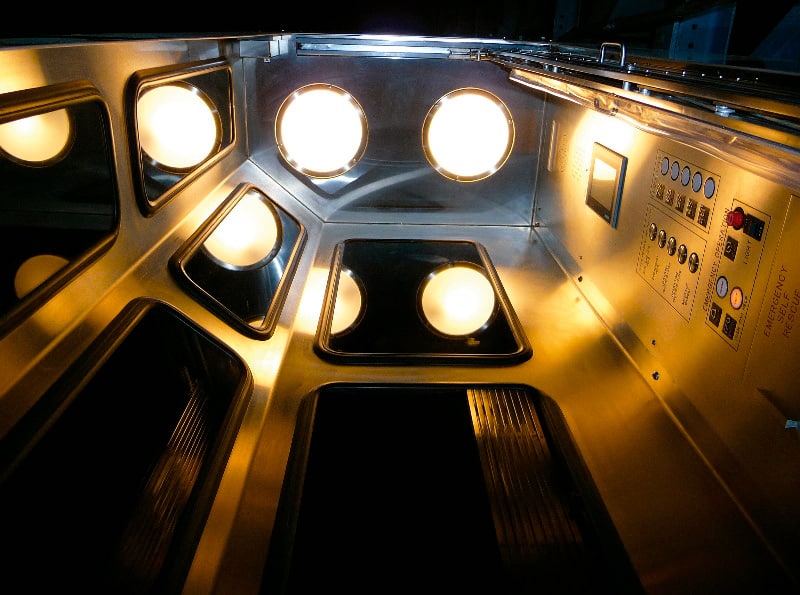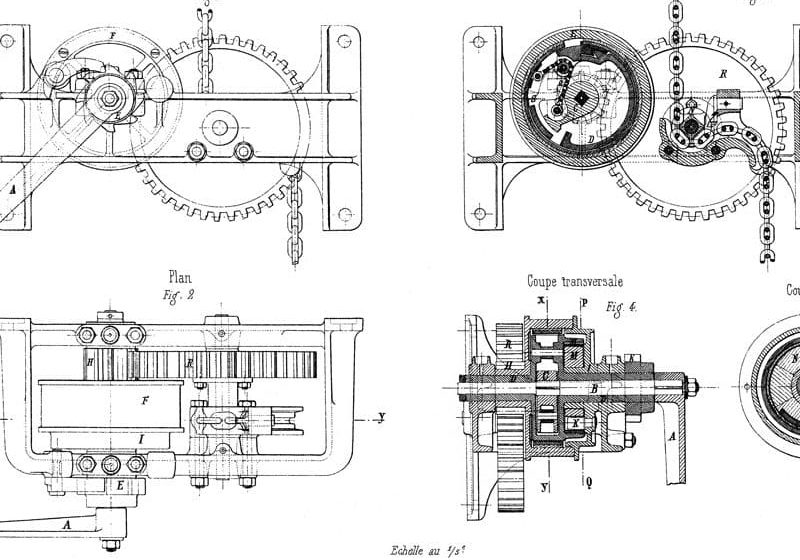The Statue of Liberty – Life and Safety Upgrades, Liberty Island, New York
Jan 1, 2014

Category 1: Elevators, New Construction
submitted by Douglas J. Muttart and TinaMarie Cortina, Liberty Elevator Corp.
The Statue of Liberty is synonymous with American freedom. When the terrorist attacks of September 11, 2001, occurred, that freedom was visibly shaken. Despite those horrific events, Americans emerged with a sense of resilience and determination reflective in our nation’s history of prevailing under the direst of circumstances. Throughout the chaotic few months that followed, Lady Liberty stood tall as a constant reminder that we would persevere.
Due to increased national security following the terrorist attacks, the statue was closed for three years. Only in 2009 was its crown reopened to the public. In an effort to make the statue a safer and more accessible attraction for visitors, Ken Salazar, former secretary of the interior, vowed to continue upgrading the interior systems and bring them up to current code.
In 2011, the request for proposal for the Statue of Liberty’s Life and Safety Upgrades was announced. This comprehensive upgrade included wider stairways, upgrades to the fire-suppression systems, and a complete overhaul of the vertical-transportation systems. This included removing the existing double-deck hydraulic passenger elevator and replacing it with a new machine-room-less (MRL) passenger elevator, installing a new Americans with Disabilities Act-compliant handicapped lift and installing a state-of-the-art emergency rack-and-pinion elevator. All elements of this project were required to adhere to a strict “Buy American” policy. This meant that every nut, bolt and screw had to be derived from facilities in America.
Joseph A. Natoli Construction Corp. was awarded the project as the general contractor and was overseen by Atkins Construction, North America, which was in charge of the overall construction management by the National Park Service. When choosing its prime elevator contractor, Natoli understood the importance of choosing a company with a reputable history and the required experience needed to construct within the preexisting conditions of a national landmark. Liberty Elevator Corp. was chosen for the job, in part because 25 years prior, Douglas K. Muttart, late father and husband of its current owners, Douglas J. Muttart, Darren Muttart and Janet Muttart, installed the original passenger elevator for the 1986 Liberty Weekend; at the time, this was the largest double-decker hydraulic elevator in the U.S.
Liberty faced several challenges in creating and implementing its custom design plan. Advanced computer simulation provided by its engineering and manufacturing groups was utilized to assist with the design of a custom passenger elevator. The entire monument was also surveyed using precision-based 3D laser technology to ensure no element was overlooked.
This high-profile project brought logistical and technical challenges: because Lady Liberty resides on an island, all of the materials had to be delivered by boat. Careful planning and project management were required to ensure the delivery and installation of materials would proceed without disturbance. It also had to be remembered that, although Lady Liberty has stood tall for over a century, the wind stress actually sways the entire structure: with a 50-mph wind, it sways 3-5 in.
Not only was it required that every component of the elevator system be American made, they also had to comply with strict specifications that could not be altered. These included the design, manufacture and construction of a passenger elevator that could accommodate a stretcher, without any room to widen the shaft, change the overhead or reduce the interior dimensions. Liberty quickly began brainstorming with Elevator Doors, Inc./Elevator Cabs, Inc. (EDI/ECI) and Motion Control Engineering. EDI/ECI and Liberty had the unique advantage of having collaborated on the design and implementation of the original 1986 elevator. Together, they were able to design a revolutionary Freedom® MRL elevator package that complied with the guidelines put forth by the U.S. National Park Service and boasted a regenerative drive that performs on 60% less horsepower than the original elevator.
The pedestal elevator was only one-third of the entire vertical-transportation work. For the first time in the structure’s history, handicapped visitors would be able to access the observation deck on level 6P. Kamran Shushtarian, owner of Mobility Elevator & Lift Co., comments, “It was a very moving experience when I watched a local news program covering a handicapped individual using the wheelchair lift and having access to our most cherished symbol of freedom.”
Additionally, a new emergency elevator replaced the existing obsolete elevator to allow injured visitors a safer and more efficient means of being transported out of the statue. The emergency elevator is strictly for emergency personnel and maintenance activities and is the only elevator installed within the body of the statue. The elevator was installed adjacent to the spiral staircases, allowing emergency personnel to reach distressed visitors at four intervals along the route. With a carrying capacity of three people, it provides an enhanced safety feature, which allows the visitor to be transported safely to the main elevator for complete egress from the monument without having to navigate the stairs.
Todd Grovatt, president of Tower Elevator Systems, Inc. (TESI), which manufactured the rack-and-pinion lift, explained:
“One of the major challenges of the project was the incredibly tight space inside the statue. It required a highly innovative and customized design, making sure the system attached to the exact same points as the old elevator, with no modifications to the historically protected interior statue structure. Our rack-and-pinion technology allows the flexibility for an elevator to be placed just about anywhere you can mount the hoistway gear rack. The rescue elevator was custom designed specifically for this application and location. It is the only elevator of its kind in the world.”
With Van Deusen & Associates (VDA)’s approval and oversight, Liberty chose what it felt were the most motivated, advanced and trusted American manufacturers. As stated by Doug Muttart, Liberty president:
“The fact [there] are three different father and son firms with direct association to Lady Liberty, spanning two generations, is a testament to the gift a parent can pass down to [his or her] children and how proud a son can make his dad. All I can say is, ‘Thank you, Dad, I wish you were here to see it completed again, and sorry we had to rip your old elevators out, but Darren and I needed to do the project one more time.’”
This comprehensive vertical-transportation project required the thoughtful and creative planning, design and execution by a team of seasoned, yet innovative, elevator professionals. Liberty was able to assemble a team to accomplish this, from start to finish, in 13 months. When Liberty learned of the intent to remove Douglas K. Muttart’s double-decker hydraulic elevator, brothers and current Liberty owners Doug and Darren Muttart understood the significance of their father’s legacy. The end result was three new elevators worthy of allowing visitors to experience Lady Liberty well into the 21st century.
The Pedestal (Main Passenger) Elevator
The main elevator was replaced with an MRL elevator boasting a regenerative drive and the ability to transport passengers at 200 fpm. As the elevator car decelerates, excess power is filtered and returned to the main power line for use by other electrical loads within the Statue of Liberty. The 2500-lb.-capacity unit travels from levels 1P–5P, a distance of 115 ft., 1-3/4 in. There is an escape hatch in the rear panel of the cabin designed specifically so the interior ventilation equipment for the monument can be accessed for maintenance.
The elevator provides for freedom of choice for the U.S. National Park Service, as all parts are nonproprietary, and there are no restrictions on maintenance material or technical support. In addition to all structural steel and hardware materials being U.S. products, all structural-material fabrication was performed in the country.
Handicapped Lift
A new handicapped lift was additionally installed. This lift travels from levels 5P-6P and is meant solely for handicapped visitors. This provides a travel distance of approximately 14 ft., 9 in. Most other wheelchair lifts are limited to 12-14 ft. of rise. This limited-use/limited-accessibility lift has a 750-lb. capacity.
Emergency Elevator
The existing emergency elevator was replaced with a 750-lb.-capacity rack-and-pinion elevator for emergency use. It travels at a rate of 150 fpm and distance of 89 ft., 8 in. to levels 6P, 4S, 5S, 6S and 7S. This system offers unique safety features, including the “Full Height Hydraulic Rescue Lowering System” (U.S. Patent No. 8191689, “Rescue Lowering”). This allows the self rescue of a stranded rider from any height without having to stop to cool the brakes (like old centrifugal systems).
Laser positioning, closed-loop feedback and a touchscreen car-operating panel are key elements of this elevator. TESI’s gear-driven rack-and-pinion technology allows for an elevator to be placed nearly anywhere the hoistway gear rack can be mounted and minimizes impact on the support structure. The custom elevator will also be used to provide emergency personnel alternate access without having to use the stairs.
Credits
- Elevator contractor and installer: Liberty Elevator Corp.
- Pedestal elevator manufacturer: Motion Control Engineering Manufacturer of emergency rack-and-pinion elevator: Tower Elevator Systems, Inc.
- Manufacturer of handicapped lift: Savaria, distributed by Mobility Elevator & Lift Co.
- Cab and entrances manufacturer: Elevator Doors, Inc./Elevator Cabs, Inc. Consultant/engineer: Van Deusen & Associates
- General contractor: Joseph A. Natoli Construction Corp. Construction manager: Atkins Construction, North America
- Owner: U.S. National Park Service/Department of the Interior
Get more of Elevator World. Sign up for our free e-newsletter.







